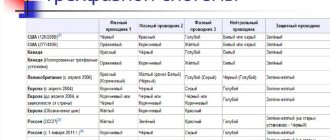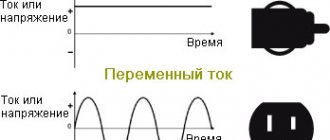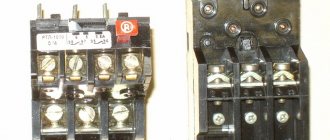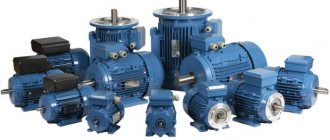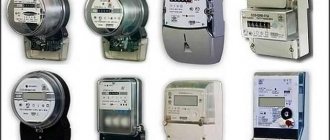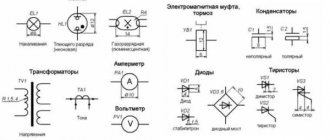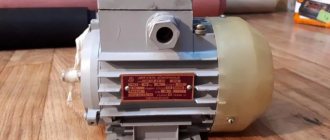Scheme of AVR 380V with diesel generator set
a diesel generator set (DGS) is provided as the third power source .
Power supply to consumers from three independent power sources is provided for consumers of the 1st category of a special group, when uninterrupted operation is necessary for an accident-free shutdown of production in order to prevent a threat to human life, explosions and fires in accordance with the PUE 7th edition, clause 1.2.18.
The peculiarity of this scheme is that when both inputs are disconnected, in the event of an accident or the inputs were manually disconnected, for example, to check (repair) electrical equipment, the diesel generator set is automatically started and the load is connected to it. When the voltage is restored at any of the inputs, it automatically switches to its original state. Figure 1 shows a diagram of an automatic transfer switch with a diesel generator set made on contactors in a single-line image.
Fig. 1 – Diagram of an automatic transfer switch with a diesel generator set on contactors in a single-line image
First launch and setup
After installation, you need to fill the power station with fuel, lubricants, coolant and connect the device to the battery. Before the first start, you need to carefully check the tightness of connections, pipes, locking devices, and electrical circuits. When the device is started, adjustments are made to ensure continuous operation within the specified specifications.
You can carry out the first start using a pre-heater, which can significantly increase the operating period of the generator, the duration of continuous operation, the starting speed and the level of maximum speed (several times), reduce the average fuel consumption, the degree of natural wear of the power plant and additional devices, and ensure the uninterrupted operation of the unit .
There is a method for the first launch, which involves placing the power plant inside a special container.
Launching in this way is beneficial for several reasons:
- High level of mobility , thanks to which the operating unit can be moved without any restrictions.
- No delays at start , even if the ambient temperature approaches -30 degrees. The container is equipped with automation that controls the microclimate inside it.
- Soundproofing properties . The walls of the container effectively absorb the noise created by the operating power plant.
By starting the generator in this way, you can achieve a smooth start and get benefits similar to those provided by the first method.
Operating principle of AVR
In normal mode, consumers are powered with a voltage of 380V from Input 1 or Input 2 through a common power contactor KM3, which is turned on after a certain time delay using a time relay KT1, this is done so that power is supplied when a stable operating mode occurs.
The presence of voltage at each input is controlled by voltage control relays KV1 and KV2. Switch SA1 is used to select priority input. If there is voltage on both inputs, the input whose priority is selected will be connected first (position “1” - the first input, position “0” - both inputs are disabled, position “2” - the second input).
Fig. 2 – Electrical circuit diagram of ATS with DGS on contactors
Operating principle of ATS with main inputs (Input 1 and Input 2)
For example, when the voltage disappears at Input 1, the voltage control relay KV1 is triggered and opens with its contacts the power circuit of the contactor KM1. If there is voltage at Input 2, the contacts of the KV2 relay are closed and if the KM1 contactor is in the off state, then the KM2 contactor will operate, while the KM3 contactor is in the on state and voltage is supplied to consumers through the closed power contacts of the KM1 and KM3 contactors.
The ATS is performed similarly for Input 2.
Operating principle of AVR with diesel generator set
If the voltage fails at the main inputs: Input 1 and Input 2, the generator control circuit is closed and the power circuit of the KM3 power contactor is opened. After the generator starts and the voltage control relay KV3 closes its output contact, time counting begins using a time relay with a turn-on delay KT2, which is necessary to stabilize the output parameters of the generator. At the end of the countdown, the power supply circuit of the KM4 contactor is closed and the generator power is connected.
When voltage is restored at any of the main inputs. For example, the voltage at Input 1 has been restored, in this case the voltage control relay KV1 is activated and its contacts close the power circuit of the contactor KM1. In this case, the output contacts of the contactor KM1 are closed and power is supplied to the time relay with a delay to turn on KT1.
After the end of the time countdown, the time relay KT1 closes the power circuit of the intermediate relay KL3, which in turn closes the power circuit of the coil of the contactor KM3 and opens the power circuit of the contactor KM4, after the contactor KM4 is turned off, KM3 will operate and through the closed power contacts of the contactors KM1 and KM3 voltage is supplied to consumers from the main Input 1.
Source
Choice
The buyer must determine from the very beginning which technical parameters are the most important for him. It is worth taking a closer look at these indicators:
- Weight.
- Dimensions.
- Power.
- Fuel consumption.
- Noise level.
- Duration of work.
Automation and price are parameters that are also being looked at
This is important for those who are interested in how to connect a generator to the home network, the diagram of which is posted on specialized websites
Generator operation
By parameters
Many people first look for an answer to the question of how many phases a generator should have for maximum convenient operation. To do this, you need to understand what electrical appliances will be connected. Three-phase options allow connection to both single- and three-phase devices. Single-phase ones are combined with only one type of consumer. But this does not mean that models with more phases will be better under all circumstances.
At each phase, the maximum load should be no more than 30%. This means that in reality the owners will not be able to use more than a third of the rated power that the outlet initially has. For example, the rated power of a three-phase generator is 6 kW. This means that no more than 2 kW can be removed from a regular 220 V outlet. The load still needs to be distributed over several phases when connecting a single-phase generator to a three-phase network at home.
Note! For power, they also check the parameters of the devices that are planned to be connected
It is important to have a reserve of at least 20-30%. Otherwise, you may encounter problems such as overload and work stoppage. Too much fuel will also be consumed
Too much fuel will also be consumed
Otherwise, you may encounter problems such as overload and work stoppage. Too much fuel will also be consumed.
Type
Synchronous and asynchronous types of devices are available. The choice involves a careful study of the characteristics of each of the existing models.
Asynchronous
Their main problem is their inability to handle so-called peak loads. Although these devices can also be used to maintain normal voltage readings. They are suitable for joint use with equipment sensitive to voltage surges:
- Electronic devices.
- Computer Engineering.
- Medical devices supporting gasoline generators.
Residual magnetization of the rotor is the main source of energy for such devices. Therefore, the service life of asynchronous generators is longer than that of their closest analogues. They do not require the use of cooling systems; the unit housing is completely closed. Thanks to this, protection from dust and moisture is fully guaranteed.
Interesting! The asynchronous generator is immune to short circuits. Therefore, this energy source is the optimal solution for welding machines. But such devices can be very sensitive to overloads. Therefore, it is prohibited to connect them to devices with initially high inrush currents.
Synchronous
The quality of the current in this case is lower when compared with the previous option. Suitable for providing emergency power in various circumstances:
- Offices.
- Refrigeration units.
- Electrical equipment in dachas and country houses.
- Construction projects.
Such devices also have some positive qualities:
- Resistance to short-term overloads.
- Ability to normally withstand peak loads, including mechanical loads.
But protection from moisture, dust and dirt is worse than that of asynchronous structures. After all, in order to cool, such generators need to pass a certain amount of air through themselves. A synchronous generator will be needed if devices operating with reactive loads are used. Then the power will be less.
Changeover switches
Phasing
It has already been mentioned above. It is worth buying three-phase generators only if there is a consumer with the appropriate characteristics in the house. If all the devices are single-phase, then the generator is selected of this type. This even applies to situations where there is a three-phase network connected to the house.
Network connection
Options for DGS connection diagrams
If the switching circuit between diesel generators and the central network is not designed and assembled correctly, the risk of supplying electricity from both sources increases. This leads to the failure of not only the diesel generator set, but also the consumers that were currently connected to the network.
Standard documentation sets usually include electrical diagrams of diesel generators and several options for connecting to the network. But if you have no experience in reading such documentation and no electrical installation skills, then work in this area should be entrusted to a specialist.
Switching on the diesel generator set in manual mode
In household backup and emergency power supply systems, in most cases, the transition to an autonomous source is implemented in manual mode. The simplest solution that is used is to connect the installation to the nearest available outlet, thereby powering the entire home network. It should be understood that such a diesel generator control scheme is not considered the most effective, and in some cases it is fraught with great danger. This is due to the following factors:
It is necessary to turn off the input circuit breakers or unscrew the plugs, otherwise, when the central power supply is restored, electricity will come from two sources.
Significant current flows through the outlet to which the unit is connected when several consumers are connected, this causes its failure. In some cases, damage to wiring sections that are not designed for such a load may occur.
A more correct scheme is considered to be a connection directly to the network after the meter with the installation of an additional machine at the output of the generator. In this case, when the centralized power supply is turned off, the circuit breaker is turned off, the diesel generator is started, and then the load is connected. But even in this case, if the turn-on/switch-off sequence is violated, there is a risk of supplying power from two sources.
Therefore, for manual starting, you should use a circuit using a changeover or paired switch with a lock or a reversing switch. The design of these devices prevents the simultaneous connection of a central and autonomous power supply. Thanks to this, safe operation is ensured.
Preparation for use
To ensure stable operation of the power plant, attention must be paid to preparatory procedures. These include:
- Organization of protection from environmental influences, namely exposure to sunlight or precipitation.
- Arrangement of a system responsible for forced ventilation. It will help to avoid overheating, leading to unexpected stoppage of the device or its failure.
- Organization of protection that protects the generator from sudden temperature changes.
- Using a connection scheme that prevents various impurities from entering the system: construction dust, exhaust gases, smoke or chemicals.
To ensure effective cooling, it is necessary to clear a space around the device within a radius of 1.5 meters.
As protection, you can use a special all-weather casing with noise-insulating properties. Useful video on this topic
Electrical diagram of diesel power station - connection in different modes
Regulatory documents use different designations for the diesel generator in the diagram. In most cases, a diesel generator set is presented in the form of a circle with the Russian letter “G” or Latin “G” with an AC or DC symbol placed inside.
The electrical circuit of the diesel generator will allow you to correctly connect the device to the network and the load. Single-line drawings show the power lines necessary to connect individual elements.
In addition to the designation of the diesel generator set, the diagram shows the installation control panel, automatic transfer switch, switching equipment of the bypass channel, and the distribution board to which consumers are connected.
Electrical connection diagrams for diesel power plants are presented in the package of operational documentation for each installation.
Schematic diagram of a diesel generator
The schematic diagram is more informative. It gives an idea of the individual elements of the diesel generator set - the generator and control panel control devices, the charging system necessary to maintain the battery, regulators and other devices that ensure the operation of the equipment.
The diagram additionally provides information about the purpose of individual contacts, which will help avoid errors when connecting to the network and load. In addition, the circuit diagram gives an idea of the operating principle of the equipment. It is indispensable for troubleshooting and repairing the electrical part of the generator. A diagram of this type is also presented in the technical documentation for the installation.
Source


